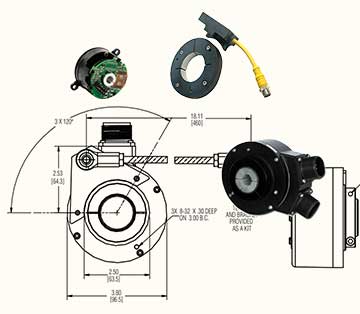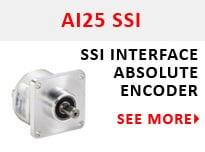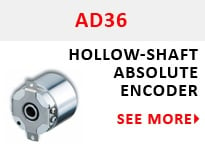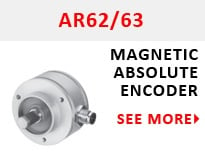- Industrial Encoder
- Motor Encoders
- Resolvers
- Incremental Encoders
- Absolute Rotary Encoders
- Magnetic Encoders
- Optical Shaft Encoders
- Optical Rotary Encoders
- Hollow-Shaft Encoders
- Quadrature Encoders
- Draw Wire Encoders
- Hall-Effect Encoders
- Hazardous Location Encoders
- Functional Safety Encoders
- Encoder Interface Protocols
- BiSS Encoders
- SSI Encoders
- Gray Code Encoders
- What is an Encoder?
- Electric Motor Controllers
- Types of Safety Encoders
SSI Encoders Overview
SSI encoders offer an all-digital, serial, point-to-point communication interface providing unidirectional communication at speeds up to 1.5MHz
SSI stands for Synchronous Serial Interface and is commonly used with standalone absolute encoders given that it is a point-to-point, one slave per master configuration.
Learn more about all absolute encoder interface protocols here
SSI Encoder Communication Format
The data frame length of SSI encoders depends on the control device and resolution. In an SSI interface, there is one slave per master, referred to as a point-to-point connection. The clock remains high until the master needs information from the sensor. It then sends a stream of clock pulses equivalent to the number of bits of information from the encoder. Samples of each bit are usually taken on the falling edge of the clock pulse. This insures that the propagation and process delays are accounted for. Encoder manufacturers are free to insert alarm bits if required, but the requirement must be provided before the product is shipped, and a single alarm bit may have several meanings.

SSI Encoder Options
SSI absolute encoders come in several protocol options depending on the desired output format.
- SSI gray code encoder output: Gray code encoder output produces only a single bit change at each step, which can reduce errors. Learn more about gray code here.
- SSI binary encoder output: Unlike gray code, binary encoder output provides signal data as a multi-bit word with multiple bit changes at each step.
- SSI encoder output with Sin-Cos 1Vpp: Some encoders also provide a 1V p-to-p sin/cos output for real-time control, since the on-demand absolute encoder data can come in too slowly for many control loops.
- SSI encoder output with SSI extended: SSI extended can provide parity or an alarm that can represent any condition.
SSI encoders may also be supplied with additional incremental outputs for speed feedback. For serial communications, one pair of wires is for a differential clock signal and the other pair is for data feedback from the sensor.
Popular SSI Encoders
Looking for a Custom Solution?
Tell us your requirements and our application engineers will help find the right solution today.
Contact Us →




